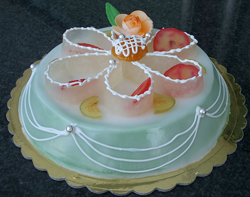利用者:ベーコンエッグ2号/sandbox
| Cassata | |
|---|---|
 | |
| 別名 | Cassata siciliana |
| 発祥地 | Italy |
| 地域 | Sicily |
| 主な材料 | sponge cake, fruit juice or liqueur, ricotta, candied peel, chocolate or vanilla filling, marzipan, icing |
| 派生料理 | Cassata a forno (in oven), cassata catanese |
カッサータ、あるいはカッサータ・シチリアーナとは、イタリアのシチリア島のパレルモ発祥の、伝統あるスイーツである。
a traditional sweet from all areas of Sicily, Italy, born in Palermo.[1][2] Cassata consists of round sponge cake moistened with fruit juices or liqueur and layered with ricotta cheese and chocolate chips (which is also the cannoli's filling). It is covered with a shell of marzipan, pink and green pastel colored icing, and decorative designs. The cassata is topped with candied fruit depicting cherries and slices of citrus fruit characteristic of Sicily. Cassata may also refer to a Neapolitan ice cream containing candied or dried fruit and nuts.
Origin
[編集]It is claimed that the Sicilian word cassata did not derive from Arabic qashatah ("bowl"), as is often claimed, but from caseata ("cheese concoction"), according to John Dickie,[3] who observes that cassata did not even signify a dessert until the late 17th century and did not take on anything like its current striped green-and-white form until the 18th century. "Cassata" he finds, "is the subject of an invented tradition based on the claim that its roots lie in the Muslim Middle Ages. Many other local food traditions purport to be as old."[4]
However, its Arab origins are generally supported.[5] The Arabic name al-Qassāṭỉ (Arabic for 'cassata-maker') is first mentioned in Corleone in 1178[6][7] and cassata is believed to have been first made in its elementary form in Palermo during Muslim rule in the 10th century.[8] The Arabic word qas'ah, from which cassata is generally believed to derive, refers to the bowl that is used to shape the cake.[9][10]
Variations
[編集]
Unlike the round, traditional shape some cassata are made in the form of a rectangle, square, or box. It may be noted that the word "box" in Italian is cassa, although it is unlikely that the word cassata originated from this term.
Cassata Catanese, as it is often prepared in the Sicilian province of Catania, is made similar to a pie, containing a top and bottom crust, filled with ricotta, and baked in the oven.
The Cassatella di Sant'Agata (pl. cassatelle)—colloquially named Minni di Vergini, meaning "virgin breasts"—is a similar dessert, but made in a smaller, personal-serving size, with a candied cherry on top, and often a specifically green-coloured marzipan. It is typically made in Catania for the festival of Saint Agatha. The allusion to the female breast relates the specific torture Saint Agatha faced as a Catholic martyr.[要出典]
When a cassata is made, layers of gelato (Italian ice cream) can be substituted for the layers of cheese, producing a dessert similar to an ice cream cake. The version of the recipe followed in Messina is less sweet than the one used in Palermo. "Cassata" can also refer to a flavor of ice-cream inspired by the sweet.
United States
[編集]In and around Northeast Ohio, particularly in the Cleveland area, the term "cassata cake" refers to a sponge cake soaked in syrup or rum, filled with strawberries and custard, and covered with sweetened whipped cream. This Cleveland version of the cassata first appeared in the early 1920s at LaPuma Spumoni & Bakery in Cleveland. The children of the owners did not like traditional cassata cake, made with sweetened ricotta, chocolate chips, and candied fruit. Using what they had in the bakery, Tomasso LaPuma created what was to become known as the Cleveland cassata cake. The fifth generation of this bakery, now located in the city's eastern suburb of Chesterland,[11] still continues to make the original version of this cake, as do many other Italian bakeries in the area.[12]
In Portland, Oregon cassata has come to mean a cake soaked with coffee liqueurs and espresso, due mainly to it being offered on the menu of only one establishment in the area. This version is made using Kahlua and espresso, with sweet ricotta and bittersweet chocolate shavings.[13] The variation differs from most recipes by having no fruit flavors or ingredients in the cake itself, and instead incorporating the more bitter coffee flavors the Pacific Northwest is known for, though it is usually served with a berry reduction.
India
[編集]In India, 'cassata' refers to a layered ice cream,[14] similar to Neapolitan ice cream, with three flavors, usually pistachio, vanilla, and strawberry, on a base of sponge cake, topped with chopped nuts.
References
[編集]- ^ “Dai musulmani agli spagnoli: ecco le mutazioni della cassata siciliana”. Cibodistrada.it (2016年3月26日). 2016年10月22日閲覧。
- ^ “Gastronomia”. Web.tiscalinet.it. 2016年10月22日閲覧。
- ^ John Dickie, Delizia! The Epic History of Italians and Their Food (New York, 2008) p. 25.
- ^ Dickie 2008, p.30.
- ^ Alan Davidson (11 Aug 2014). Jaine, Tom. ed. The Oxford Companion to Food (illustrated ed.). Oxford University Press. p. 148. ISBN 9780199677337
- ^ Alex Metcalfe (2009). The Muslims of Medieval Italy (illustrated ed.). Edinburgh University Press. p. 252. ISBN 9780748620081
- ^ Alexander Metcalfe (21 Jan 2014). Muslims and Christians in Norman Sicily: Arabic-Speakers and the End of Islam. Routledge. p. 259. ISBN 9781317829256
- ^ Habeeb Salloum (25 Jun 2013). Sweet Delights from a Thousand and One Nights: The Story of Traditional Arab Sweets (revised ed.). I.B.Tauris. pp. 139–40. ISBN 9780857733412
- ^ Vesna Maric (2008). Sicily. Ediz. Inglese (illustrated ed.). Lonely Planet. p. 45. ISBN 9781740599696
- ^ Mary Taylor Simeti (2009). Sicilian Food: Recipes from Italy's Abundant Isle (illustrated ed.). Wakefield Press. p. 79. ISBN 9781862548503
- ^ “La Puma Bakery - Cleveland Hot List”. Cleveland.cityvoter.com. 2016年10月22日閲覧。
- ^ “Archived copy”. 2013年3月14日時点のオリジナルよりアーカイブ。2013年3月28日閲覧。
- ^ “Papa Haydn Desert Menu”. Template:Cite webの呼び出しエラー:引数 accessdate は必須です。
- ^ Murthy, Swineetha (2013年6月27日). “Sakkarai Pandhal: Cassata Icecream”. Sakkaraipandhal.blogspot.com. 2016年10月22日閲覧。
